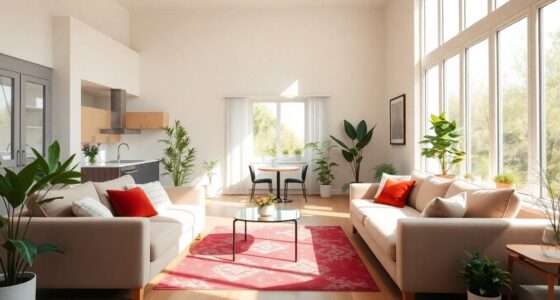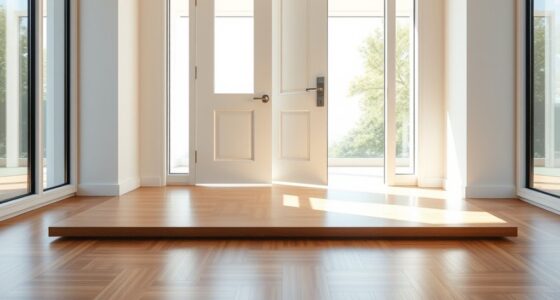To optimize your lighting for age-related vision changes, focus on using bright, diffuse, and indirect light sources to reduce glare and improve visibility. Incorporate layered lighting like ambient, task, and accent lights, and install dimmers to adjust brightness as needed. Choose warmer bulbs with higher contrast to enhance colors and details. Proper fixture placement helps prevent reflections and shadows. Keep exploring for more tips that can make your space safer and more comfortable.
Key Takeaways
- Use diffuse, indirect lighting and fixtures with shades to minimize glare and ensure even illumination.
- Incorporate layered lighting—ambient, task, and accent—to adapt to different activities and lighting needs.
- Select warm color temperature bulbs (2700K–3000K) to enhance contrast and improve visibility of colors and details.
- Install dimmer switches to adjust light levels, reducing shadows and creating a comfortable visual environment.
- Position lighting fixtures thoughtfully to prevent glare, reflections, and shadows, improving safety and visual clarity.

Have you ever wondered how the right lighting can transform a space? When it comes to addressing age-related vision changes, proper lighting is essential for safety, comfort, and independence. As you age, your eyes become less efficient at adjusting to different light levels, and you might notice increased difficulty seeing in dim lighting or distinguishing colors. By optimizing your lighting setup, you can markedly improve your visual experience and reduce frustration.
One of the key considerations is glare reduction. Bright, direct light sources can cause glare, which makes it harder to see clearly and can lead to eye strain or headaches. You should aim for diffuse, indirect lighting that evenly illuminates a room without creating harsh reflections or hotspots. Using lamps with shades or diffusers helps soften the light and minimizes glare. Additionally, positioning light fixtures so that they don’t shine directly into your eyes or onto reflective surfaces can make a big difference. This approach not only enhances comfort but also helps you navigate spaces more safely, reducing the risk of trips or falls.
Color contrast becomes increasingly important as your ability to distinguish subtle differences in shades diminishes with age. To make objects and text stand out more clearly, choose lighting that enhances color contrast. Warm light bulbs, with a color temperature around 2700K to 3000K, tend to improve visibility by creating a cozy ambiance and making colors appear more vibrant. Conversely, cooler lights can sometimes wash out details, so selecting warm or neutral tones is generally more effective. When reading or working on detailed tasks, consider using dedicated task lighting with adjustable brightness and focused beams. This ensures you’re providing ample illumination exactly where you need it, making it easier to see fine details and reducing eye fatigue.
Adjusting your environment to optimize lighting isn’t just about brightness; it’s about creating a balanced and comfortable visual setting. Incorporate layered lighting—ambient, task, and accent lights—to provide flexibility and control. Dimmer switches give you the ability to fine-tune light levels throughout the day, accommodating different activities and natural light changes. Remember to eliminate stark contrasts between light and shadow, as this can cause visual discomfort and hinder clarity. Instead, aim for a uniform, well-distributed light that enhances visibility without overwhelming your eyes. Additionally, choosing high-quality lighting fixtures that provide consistent light output can further improve visual comfort and safety in your space.
Frequently Asked Questions
How Does Aging Affect Contrast Sensitivity?
As you age, your contrast sensitivity declines due to visual acuity decline and neural processing changes. This means you may find it harder to distinguish objects from their backgrounds, especially in low light or glare. Your eyes process visual information less efficiently, making it more difficult to detect subtle differences in shades and patterns. To compensate, you might need better lighting and contrast-enhanced environments to improve visibility and safety.
What Are the Best Light Bulb Options for Seniors?
Think of your home lighting as a guiding lighthouse; smart bulbs and energy-efficient lighting are your best options. They offer adjustable brightness and color temperatures, making it easier to see clearly. Smart bulbs can be customized for different needs, reducing eye strain. Choose LED options for longevity and energy savings. These choices help create a well-lit environment that adapts to your vision, ensuring safety and comfort every day.
Can Lighting Improvements Reduce Glare Issues?
Yes, lighting improvements can reduce glare issues. You should focus on glare reduction by adjusting lighting placement, such as directing lights away from your eyes and using fixtures with diffusers. Adding task lighting instead of harsh overhead lights can help, and choosing bulbs with softer, warmer tones minimizes glare. Properly positioned lighting makes your environment more comfortable, reducing eye strain and improving visibility, especially for age-related vision changes.
How Do Color Temperatures Influence Vision in Older Adults?
Imagine walking into a cozy, sunlit room where warm hues gently embrace your surroundings. You notice that warmer color temperatures enhance your color perception and provide a sense of visual warmth, making it easier for older adults to see clearly. Cooler tones, on the other hand, can cause glare and strain. Choosing the right color temperature helps improve clarity, reduces eye fatigue, and creates a more comfortable viewing experience.
Are There Specific Lighting Guidelines for Elderly Individuals?
Yes, there are specific lighting guidelines for elderly individuals. You should use adaptive lighting that adjusts brightness and color temperature to reduce eye strain. Incorporate bright, glare-free lighting in task areas, and consider vision therapy to strengthen visual skills. Proper lighting helps improve clarity and comfort, making daily activities easier. Always guarantee light sources are positioned to minimize shadows and glare, supporting safer, more effective vision for older adults.
Conclusion
As you brighten your space, you become the artist painting clarity into your world. Think of good lighting as a guiding lighthouse, cutting through foggy vision and illuminating every detail. By making simple adjustments, you take control and transform dim, blurry days into a clear, vibrant journey. Embrace these changes, and watch your surroundings come alive with sharper lines and brighter colors—your personal lighthouse guiding you safely through the shadows of age-related vision changes.








